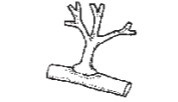Motivation
Lichens and mosses have been used as bioindicators for environmental pollution because many species, especially those that live on trees (aka epiphytic , from epi- "upon" + -phyte "plant), obtain all their nutrients from the surrounding air, moisture, and rain. This means that they also absorb many of the chemicals and pollutants present in the air and serve as mini living air quality monitors. How cool is that?
But before we can use these organisms as bioindicators, we must first be able to identify them. Once you learn how to spot them, you might start seeing them everywhere!
Lichen
Did you know lichen are not plants? They're actually a symbiotic relationship between fungi and a photobiont (an organism that lives on sunlight), usually algae and/or cyanobacteria. You can find them on the bark of trees, on leaves, on wooden benches, and even on rocks, and while they're usually pale gray or light green, they can come in all colors. Because they can't store water, they usually prefer shadier spots where sunlight won't immediately evaporate all their moisture. They're also sensitive to air pollution, so if you're in a highly polluted area, chances are you won't see much lichen (though just because you don't see lichen doesn't necessarily mean the pollution is off the charts; there may be other factors).
There are three main types:
| Crustose (Crusty) | Foliose (Leafy) | Fruticose (Shrubby or bushy) |
|---|---|---|
| Crustose lichens are pressed against their substrate and can come in bright, vibrant colors like sunny yellow, orange, and red, as well as grays and greens. | "Leaves" grow parallel to substrate, and the leaf-like lobes can be flat, lettuce-like, or bumpy and ridged. | Fruticose lichens grow outwards from their substrate and can be similar to wispy hair, small cups, or shrubs. |
 |
 |
 |
| Least sensitive to pollution | Moderately sensitive to pollution | Most sensitive to pollution |
Check out these links for more examples (warning: possible trigger for trypophobia):
- OPAL Air Survey Lichen Identification Guide
- Meet the Lichen
- Leif Stridvall
- Stephen Sharnoff
- Search for Lichens by Characteristic
- Video on Identifying Lichens in the Field and with Chemical Testing
Moss
Mosses are plants with small leaf-like structures and stems, and like lichen, they tend to grow on tree branches or trunks and like moist, dark areas. Check the side of the tree that receives the least sunlight. Some species can also grow on soil, rocks, brick, and even poop! They can look like small tufts of leaves, or in sufficient quantities, they can form dense green cushions.
| Acrocarp (Upright) | Pleurocarp (Branching) |
|---|---|
| Erect and unbranched | Form spreading carpets and branch freely |
| Slow growth | Rapid growth |
Check out these links for more examples:
Tips
- Magnifying glasses can be helpful, but not necessary
- Make sure to stay on marked paths
- Algae can be confusing to distinguish from moss and lichen since they are also found on tree trunks and on the leaves of evergreen trees and shrubs. They typically appear as greenish powder on trunks.
Go Out and Explore!
You can start looking for these organisms on your next neighborhood walk or hike! Post some pictures and and share any tips for fellow lichen and moss spotters ^_^

4 Comments
Wow! 😲 This sounds very interesting! I am gonna do it!
yay~ excited to see how it goes, keep us posted!
Reply to this comment...
Log in to comment
I did this!
I found this 👆
It was in a big park of Córdoba city, in Argentina. This city has at least 1,000,000 population. In the urban and with high traffic I couldn't find any.
Here a link where I upload the observation. 👇 https://www.inaturalist.org/observations/88209717
Bye 🎈
Is this a question? Click here to post it to the Questions page.
Reply to this comment...
Log in to comment
Awesome post:) I found lots of lichen on the oak trees in my town! Foliose I think.
Here's a bonus shot of all the Spanish moss growing on the oak trees too---however, it turns out "Spanish moss" is a complete misnomer as its not actually from Spain or moss (it's an epiphyte). I prefer the Native American term, Itla-okla, which translates to "tree hair"!
Is this a question? Click here to post it to the Questions page.
Reply to this comment...
Log in to comment
Login to comment.